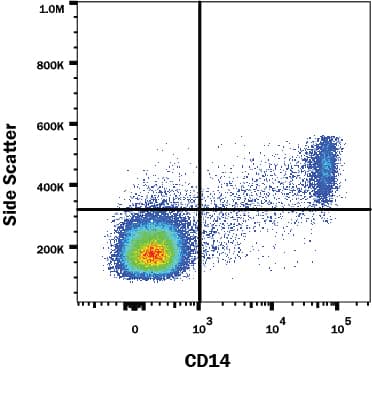Human CD14 Antibody
R&D Systems, part of Bio-Techne | Catalog # MAB3832


Key Product Details
Species Reactivity
Validated:
Cited:
Applications
Validated:
Cited:
Label
Antibody Source
Product Specifications
Immunogen
Thr20-Cys352
Accession # P08571
Specificity
Clonality
Host
Isotype
Endotoxin Level
Scientific Data Images for Human CD14 Antibody
Detection of Human CD14 by Western Blot.
Western blot shows lysates of human peripheral blood mononuclear cells (PBMC). PVDF membrane was probed with 2 µg/mL of Mouse Anti-Human CD14 Monoclonal Antibody (Catalog # MAB3832) followed by HRP-conjugated Anti-Mouse IgG Secondary Antibody (HAF018). A specific band was detected for CD14 at approximately 55 kDa (as indicated). This experiment was conducted under non-reducing conditions and using Western Blot Buffer Group 1.Detection of CD14 in Human PBMCs by Flow Cytometry.
Human peripheral blood mononuclear cells (PBMCs) were stained with Mouse Anti-Human CD14 Monoclonal Antibody (Catalog # MAB3832) followed by Goat anti-Mouse IgG APC-conjugated Secondary Antibody (Catalog # F0101B). View our protocol for Staining Membrane-associated Proteins.Detection of CD14 in human tonsil.
CD14 was detected in immersion fixed paraffin-embedded sections of human tonsil using Mouse Anti-Human CD14 Monoclonal Antibody (Catalog # MAB3832) at 5 µg/mL for 1 hour at room temperature followed by incubation with the Anti-Mouse IgG VisUCyte™ HRP Polymer Antibody (Catalog # VC001). Before incubation with the primary antibody, tissue was subjected to heat-induced epitope retrieval using VisUCyte Antigen Retrieval Reagent-Basic (Catalog # VCTS021). Tissue was stained using DAB (brown) and counterstained with hematoxylin (blue). Specific staining was localized to cell surface in lymphocytes. View our protocol for IHC Staining with VisUCyte HRP Polymer Detection Reagents.Applications for Human CD14 Antibody
CyTOF-ready
Flow Cytometry
Sample: Human peripheral blood monocytes
Immunohistochemistry
Sample: Immersion fixed paraffin-embedded sections of human tonsil
Western Blot
Sample: Human peripheral blood mononuclear cells (PBMC)
Neutralization
Reviewed Applications
Read 2 reviews rated 4.5 using MAB3832 in the following applications:
Formulation, Preparation, and Storage
Purification
Reconstitution
Formulation
Shipping
Stability & Storage
- 12 months from date of receipt, -20 to -70 °C as supplied.
- 1 month, 2 to 8 °C under sterile conditions after reconstitution.
- 6 months, -20 to -70 °C under sterile conditions after reconstitution.
Background: CD14
CD14 is a 55 kDa cell surface glycoprotein that is preferentially expressed on monocytes/macrophages. The human CD14 cDNA encodes a 375 amino acid (aa) residue precursor protein with a 19 aa signal peptide and a C-terminal hydrophobic region characteristic for glycosylphosphatidyinositol (GPI)-anchored proteins. Human CD14 has four potential N-linked glycosylation sites and also bears O-linked carbohydrates. The amino acid sequence of human CD14 is approximately 65% identical with the mouse, rat, rabbit, and bovine proteins. CD14 is a pattern recognition receptor that binds lipopolysaccharides (LPS) and a variety of ligands derived from different microbial sources. The binding of CD14 with LPS is catalyzed by LPS-binding protein (LBP). The toll-like-receptors have also been implicated in the transduction of CD14-LPS signals. Similar to other GPI-anchored proteins, soluble CD14 can be released from the cell surface by phosphatidyinositol-specific phospholipase C. Soluble CD14 has been detected in serum and body fluids. High concentrations of soluble CD14 have been shown to inhibit LPS-mediated responses. However, soluble CD14 can also potentiate LPS response in cells that do not express cell surface CD14.
References
- Wright, S.D. et al. (1990) Science 249:1431.
- Pugin, J. et al. (1993) Proc. Natl. Acad. Sci. USA 90:2744.
- Beutler, B. (2000) Current Opinion in Immunology 12:20.
- Stelter, F. (2000) Chem. Immunol. 74:25.
Alternate Names
Gene Symbol
UniProt
Additional CD14 Products
Product Documents for Human CD14 Antibody
Product Specific Notices for Human CD14 Antibody
For research use only

